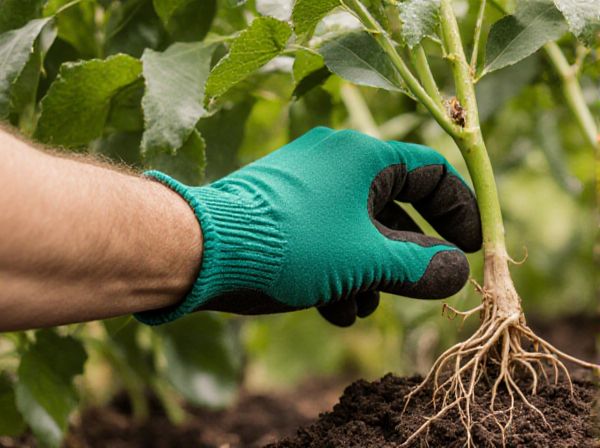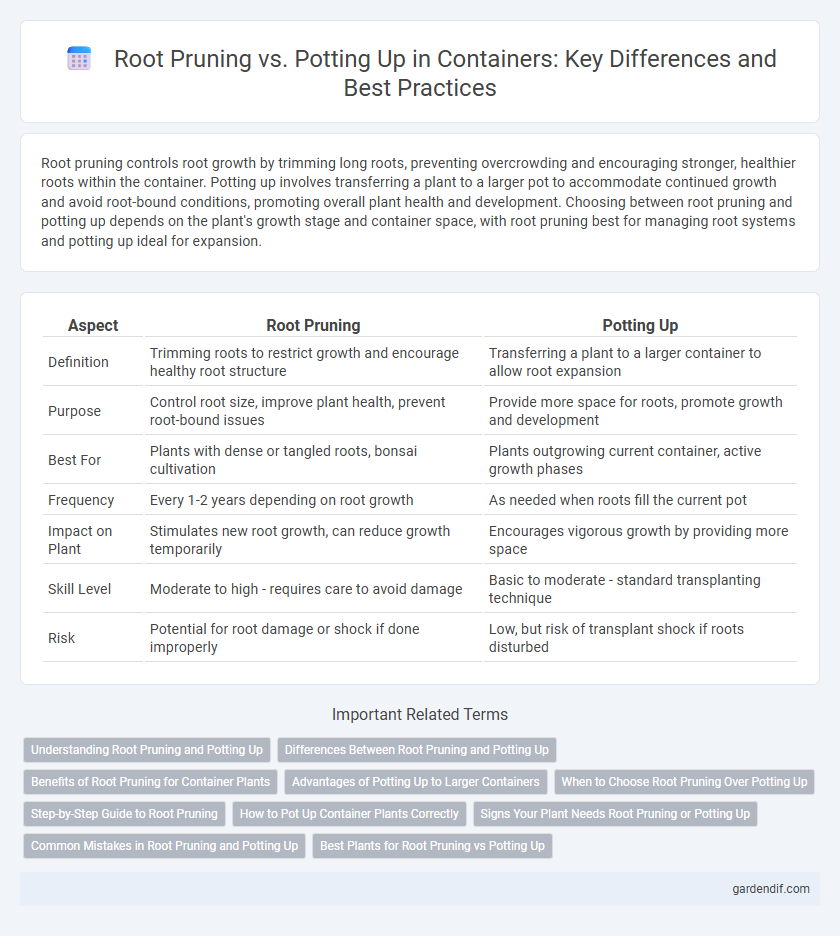
Root pruning vs potting up Illustration
Root pruning controls root growth by trimming long roots, preventing overcrowding and encouraging stronger, healthier roots within the container. Potting up involves transferring a plant to a larger pot to accommodate continued growth and avoid root-bound conditions, promoting overall plant health and development. Choosing between root pruning and potting up depends on the plant's growth stage and container space, with root pruning best for managing root systems and potting up ideal for expansion.
Table of Comparison
| Aspect | Root Pruning | Potting Up |
|---|---|---|
| Definition | Trimming roots to restrict growth and encourage healthy root structure | Transferring a plant to a larger container to allow root expansion |
| Purpose | Control root size, improve plant health, prevent root-bound issues | Provide more space for roots, promote growth and development |
| Best For | Plants with dense or tangled roots, bonsai cultivation | Plants outgrowing current container, active growth phases |
| Frequency | Every 1-2 years depending on root growth | As needed when roots fill the current pot |
| Impact on Plant | Stimulates new root growth, can reduce growth temporarily | Encourages vigorous growth by providing more space |
| Skill Level | Moderate to high - requires care to avoid damage | Basic to moderate - standard transplanting technique |
| Risk | Potential for root damage or shock if done improperly | Low, but risk of transplant shock if roots disturbed |
Understanding Root Pruning and Potting Up
Root pruning involves trimming the roots of a plant to encourage healthy growth and prevent root binding, whereas potting up refers to transferring a plant to a larger container to provide more space for root expansion. Effective root pruning improves aeration and nutrient absorption by removing circling or damaged roots, promoting vigorous development. Potting up supports plant growth by reducing root crowding, allowing the root system to establish more efficiently and sustain greater above-ground biomass.
Differences Between Root Pruning and Potting Up
Root pruning involves trimming the roots to control growth and prevent root-bound conditions, promoting a healthier root system and better nutrient absorption. Potting up refers to transferring a plant to a larger container to provide more space for root expansion and overall growth. The key difference lies in root pruning limiting root growth through cutting, while potting up encourages root development by increasing container size.
Benefits of Root Pruning for Container Plants
Root pruning enhances oxygen and nutrient absorption by encouraging a dense, fibrous root system within container plants. It helps prevent root-bound conditions, promoting healthier growth and improved water uptake efficiency. This technique also supports better transplant success by stimulating new root development and reducing transplant shock.
Advantages of Potting Up to Larger Containers
Potting up to larger containers enhances root development by providing ample space for roots to expand, reducing the risk of root circling and improving nutrient uptake. It promotes healthier plant growth through better aeration and moisture retention compared to root pruning, which can stress the plant and stunt growth. Larger containers also reduce transplant shock, ensuring a smoother transition and sustained plant vigor.
When to Choose Root Pruning Over Potting Up
Root pruning is ideal when plant roots become densely packed or start circling inside the container, limiting nutrient absorption and growth. Choose root pruning for maintaining plant size, preventing root-bound conditions, and promoting healthy root architecture in limited space. Potting up suits plants needing immediate space expansion, but root pruning optimizes long-term root health and container plant vigor.
Step-by-Step Guide to Root Pruning
Root pruning involves carefully trimming a plant's roots to encourage healthy growth and prevent root-bound conditions in containers. Begin by gently removing the plant from its pot, then use clean, sharp tools to cut away circling or excessively long roots, focusing on preserving the root ball's core. After pruning, repot the plant into fresh soil, ensuring adequate space and proper drainage to promote vigorous root development and overall plant health.
How to Pot Up Container Plants Correctly
Potting up container plants requires selecting a slightly larger container to allow root expansion while maintaining proper soil aeration and drainage. Carefully remove the plant from its current pot, gently loosen the root ball to encourage new root growth, and place it in fresh, nutrient-rich potting mix. Water thoroughly after repotting to settle the soil and support plant recovery.
Signs Your Plant Needs Root Pruning or Potting Up
Signs your plant needs root pruning or potting up include roots circling tightly inside the container, reduced growth, and water draining too quickly or too slowly. Yellowing leaves and frequent wilting despite regular watering also indicate root-bound conditions requiring intervention. Check for roots emerging from drainage holes or visible root mass on the soil surface to determine if repotting or root pruning is necessary.
Common Mistakes in Root Pruning and Potting Up
Common mistakes in root pruning include removing too much of the root mass, leading to transplant shock and slower growth. In potting up, inadequate root disturbance often results in poor root development and reduced nutrient uptake. Failing to properly loosen root-bound plants during potting up can restrict root expansion, causing stunted growth in containers.
Best Plants for Root Pruning vs Potting Up
Root pruning is ideal for plants with fibrous root systems like tomatoes, peppers, and herbs, as it encourages healthy, compact growth and prevents root circling. Potting up suits plants with taproots or larger root balls such as shrubs, small trees, and perennials, facilitating gradual transition to bigger containers without root damage. Selecting the best method depends on plant species, root structure, and growth rate to ensure optimal container growth and plant health.
Root pruning vs potting up Infographic

 gardendif.com
gardendif.com